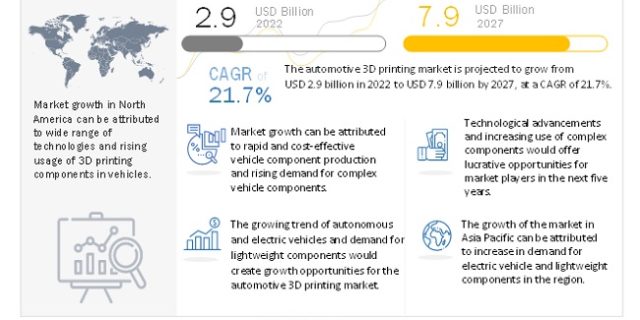
The Automotive 3D Printing Market is projected to grow from USD 2.9 billion in 2022 to USD 7.9 billion by 2027, at a CAGR of 21.7%. The need for decreased development time with fewer prototypes, which would eventually decrease the production cost, is driving the demand for 3D printing technology. Alternatively, initiatives & investments by major OEMs towards the same are further fueling the growth of the automotive 3D printing market.
Increasing initiatives & investments by major OEMs to drive the growth in automotive 3D printing
3D printing in the automotive sector is helping OEMs to reduce costs and produce cost-effective auto parts in reduced production time. Even though implementing this new technology is challenging at the beginning, OEMs have experienced a positive impact on their production process and end products. Thus, OEMs have intensified their investments in 3D printing and made it a vital part of their manufacturing process.
Companies are investing heavily in R&D, supplementing the growth of the 3D printing market. Various technological advancements in 3D printing techniques and materials in the past two decades have paved the way for new technologies that facilitate the production of different custom products. Industry leaders such as Stratasys (Israel) and 3D Systems (US) have invested significantly in 3D printing technology, which gives them a competitive advantage.
Several start-ups and small companies are investing in R&D for automotive 3D printing technologies to introduce new and innovative technologies. Some of these players are – Biomedical Modeling (US), SLM Solutions GmbH (Germany), Xilloc Medical BV (Netherlands), Surgival Group (Spain), GPI Prototype (US), and 3T RPD (UK). The advent of new 3D printing technologies and materials would create various application areas and increase the penetration of 3D printing in diverse industries. R&D focuses primarily on improving and expanding the capabilities of existing technologies and related software and materials to attain high accuracy and efficiency. Companies also attempt to develop more affordable products and a universally compatible and customer-friendly software system for 3D printing applications. The factor would have a significant impact from 2020 to 2025.
Download PDF Brochure @ https://www.marketsandmarkets.com/pdfdownloadNew.asp?id=250218997
Untapped adjacent markets for 3D printing applications
The progression of 3D printing applications from rapid prototyping to direct digital manufacturing (DDM) of products has generated interest in the future applications of 3D printing technologies in diverse fields such as healthcare, consumer products, and automotive. 3D printing possesses substantial commercial potential and will significantly impact various industries, including aerospace and medical, with more customized and sophisticated applications expected soon.
North America is estimated to be the largest market in 2022
North America is estimated to hold the largest share of the global 3D printing market in 2022; this can be attributed to the continuous technological advancements in this field and hundreds of carmakers in the region. Europe is estimated to be the fastest-growing 3D printing market and is expected to lead the 3D printing market. The major reason for this is the usage of additive manufacturing by leading automotive manufacturers extensively for their R&D, such as prototyping and fixtures. The main factor for using 3D printing in R&D is the cost-effectiveness of the technology. The polymers printed by 3D printers can be recycled for optimum usage.
The US is expected to dominate the North American automotive 3D printing market. The US has a significant production of ICE vehicles and rapid development of electric vehicles, so there is high demand for 3D-printed parts. The US is estimated to lead the plastic 3D printing market. The main reason for this is the presence of hundreds of carmakers in the country whose R&D and components such as interior trims, dashboards, and exterior components demand plastic additive manufacturing technology.
Key Market Players
The automotive 3D printing market is dominated by a few globally established companies such as Stratasys (Israel), 3D Systems, Inc. (US), EOS (Germany), Arcam AB (Sweden), Renishaw plc. (UK), HP (US), Materialise (Belgium).
Request Free Sample Report @ https://www.marketsandmarkets.com/requestsampleNew.asp?id=250218997

